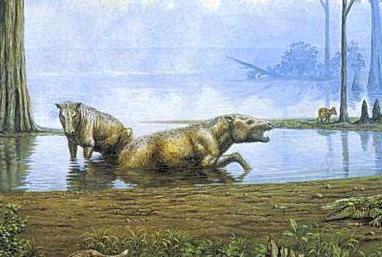Good tidings and well-wishes!
I apologize for my relative inactivity of late: the waning days of my final semester here at MCC are taking an enormous toll upon my free time which, consequently, has severely handicapped my ability to make routine posts.
To prevent TTT from going completely barren during this time, I’ve elected to showcase the following update on one of the resolutions I made just prior to the advent of the present year: namely, to increase my personal voluntary reading rate. As the title of the article suggests, this entry chronicles all of the books I’ve consumed thus far… each of which is accompanied by a short review composed by yours truly.
So, without further ado, I hereby present the first third of my 2010 booklist in chronological order.
“Neptune’s Ark: From Ichthyosaurs to Orcas” By David Rains Wallace

My Thoughts: The cover, excerpts of critical acclaim, and internal blurb all insinuate that ‘Neptune’s Ark’ is a highly accessible and evocative narration which equally blends scientific data, historical discourses, and personal observations concerning the history and conservation of marine life in North America’s west coast. However, in reality, the latter two features unambiguously dominate the text, leaving the former grossly under-represented. Though I find the history of science and the musings of eloquent naturalists to be fascinating and enjoyable topics, I don’t particularly care for being ambushed by either of them in search of ‘hard science’. With the exception of Wallace’s coverage of pinnipeds (which, in my opinion absorbs a disproportionately large amount of the book’s content), none of the strictly scientific information is technical enough to appeal to committed paleontology and zoology enthusiasts nor is it sufficiently readable and well-illustrated enough for laymen to find it comprehensible. The greatest strength of ‘Neptune’s Ark’ is unquestionably the author’s obvious passion for his subject, yet this ardor alone simply isn’t enough to save a book which attempts to please everyone and in so doing fails to please anyone.
”Beauty And The Beasts: Woman, Ape, And Evolution” By Carole Jahme

My Thoughts: As I’ve doubtlessly said elsewhere, my favorite popular science books are those which pay their philosophical dues and in so doing, provide the audience with more than a simple run-down of the featured discipline’s facts, theories, and controversies by forcing them to ponder the subject’s deeper implications for day-to-day life. To this end, I have yet to come across a scientific volume which exceeds the brilliant ‘Beauty & The Beasts’; a masterpiece of modern science writing. Jahme effortlessly brings us to sympathize with the plights and triumphs of female primatologists while never failing to address such evocative and controversial questions as ‘Why do primates tend to be almost infinitely more trusting of women than men?’, ‘Should apes be given the same rights as human citizens?’, ‘How much does the human psyche have in common with those of our nearest relatives?’, and, on a broader scale, ‘Does scientific objectivity truly exist?’. Furthermore, although most feminists will relish the book, Jahme nonetheless refuses to promote “utero-centric propaganda” by thoroughly and equally scrutinizing the observational and scientific biases of both genders in primatology. In short, ‘Beauty & The Beasts’ doesn’t contain a single sentence which would lead me to remotely considering giving it anything less than my highest recommendation. Bravo!
”The Lightning Thief (Percy Jackson And The Olympians Book One)” By Rick Riordan

My Thoughts: (WARNING: POTENTIAL SPOILERS AHEAD!!) Upon hearing a friend’s appraisal, I was encouraged to lend my eyes to a copy of this bestseller. Having completed the novel, I must admit that my feelings concerning it are mixed but mostly positive. Riordan’s overall concept of depicting the Greek Gods in the setting of the modern U.S. is absolutely superb and, as a lifelong mythology enthusiast, I relished the re-discovery of such legendary characters as Medusa, Procrustes, Charon, and Ares in their twenty-first century attire and occupations. Similarly, the story as a whole is deliciously action-packed and relatively unpredictable. Unfortunately, “‘The Lightning Thief” has obviously stolen several key plot elements from the ever-popular ‘Harry Potter’ series. Furthermore, although Riordan has certainly provided his readers with a huge amount of suspense, he also falls prey to a few long-standing clichés as well as having the occasional supposedly ‘shocking’ plot twist anticipated by the reader far in advance. Still, ‘The Lightning Thief’ offers quite a bit of entertainment for those looking for a bit of light reading.
”Parasite Rex: Inside The Bizarre World Of Nature’s Most Dangerous Creatures” By Carl Zimmer

My Thoughts: As Zimmer would have likely predicted, I’ve never really given parasites very much consideration, despite my unrestrained adoration for a ‘host’ of biological sciences. “Parasite Rex” conclusively reveals why this ignorance is scientifically unacceptable. Not only do these amazing organisms wield some of evolution’s most brilliant inventions, but an increasingly large amount of evidence suggests that they play an indispensably vital role in ecology and in environmental stability (in fact, it’s entirely possible that the majority of predator-prey relations are directly driven by them). Furthermore, Zimmer discusses how parasites may have directly led to such monumental evolutionary developments as sexual reproduction. For those intrigued by these ideas, I’d also suggest Susan Perkins’ excellent blog, ‘Parasite of the Day‘.
“When Elephants Weep: The Emotional Lives Of Animals” By Jeffrey Moussaieff Masson & Susan McCarthy

My Thoughts: This is one of those concepts which would have made for an excellent article, but ultimately collapses under the weight of a moderately-sized book. Masson and McCarthy do make some powerful arguments regarding anthropomorphism, anthropocentrism, and certain biases of the scientific and pop-culture communities at large, many of which I myself have been supporting for years. However, their most interesting points are almost entirely restricted to the introductory and concluding chapters, a fact that essentially reduces the remaining pages to a diverse but woefully repetitive collection of anecdotes, many of which can be more accurately described as mere ‘rumors’. Furthermore, although the authors clearly intended to utilize ‘When Elephants Weep’ for the purposes of convincing the scientific community to take the idea that animals have human-like emotions seriously, they’ve provided little more than a sliver of ‘hard’ scientific evidence, opting to focus almost exclusively on philosophy in its place (I fully realize that I’ve often shed a great deal of acclaim upon popular science books which ‘pay their philosophical dues’. However, this particular book does so to the exclusion of virtually any actual science). In summary, ‘When Elephants Weep’ seems incapable of winning over its intended audience, even though it will likely appeal to those who already support its central thesis.
“Survival Of The Sickest: The Surprising Link Between Disease And Longevity” By Sharon Moalem (With Johnathan Prince)

My Thoughts: Moalem’s brilliantly clear introduction to the subject of evolutionary medicine is well worth the attention of anyone seeking to broaden their knowledge of biology in general. Additionally, “Survival Of The Sickest” provides some of the finest preliminary outlines of epigenetics, ‘jumping genes’, and hypermutation I’ve ever read (all of which will ensure that you’ll never view Lamarckian evolution with the traditional dosage of contempt again). My only serious complaint hails from Moalem’s discussion of the infamous aquatic ape hypothesis in which he fully supports the notion without giving mention to any of its strongest criticisms. Still, this is but a minor point: on the whole, “Survival Of The Sickest” is an absolute must-read!
“Utilitarianism” By John Stuart Mill

My Thoughts: A quick perusal of TTT’s “About Me” page will reveal that I consider myself to be a bit of a John Stuart Mill fan. Yet most of my knowledge concerning the man’s philosophical and political ideology hails from various quotations and essays I’ve accumulated over the years. At least, such was the case prior to this past spring when I finally managed to obtain a used copy of Mill’s most famous volume. As with most classic philosophy texts, it’s wise to research the content of ‘Utilitarianism’ prior to actually reading it to better ensure comprehension whilst devouring its 1861 prose. Nonetheless, Mill brilliantly articulates the underlying principles and logic of Utilitarian philosophy through a satisfying parade of evocative and powerful arguments which force the reader to strongly reconsider his or her viewpoint on the very nature of morality itself.
“Death By Black Hole And Other Cosmic Quandaries” By Neil deGrasse Tyson

My Thoughts: I’ve frequently made much ado about the fact that I regard Hayden Planetarium astrophysicist Neil deGrasse Tyson to be one of the finest science communicators of our era as evidenced by his passionate prose, general avoidance of excessive jargon, excellent stage presence, and unique sense of humor. So, upon making the decision to widen my meager knowledge of astronomy by exploring popular science books on the subject, “Death By Black Hole” became my natural first choice. This collection of several dozen essays certainly doesn’t disappoint, serving instead as an entertaining and ceaselessly intriguing model of clarity. Tyson lends his exquisite explanatory capabilities to a host of various topics, my favorites being the emergence of light from the sun, how elements are formed and distributed by the collapse of stars, and the role of consistency in the universe. Additionally, his discussion regarding why intelligent design simply cannot be cited as ‘science’ and is demonstrably antithetical to all forms of scientific inquiry should be required reading for all students of science, philosophy, and theology. My only criticism is in light of the fact that the volume contains no illustrations or diagrams of any kind. While Tyson’s bang-up descriptive powers prevent this situation from becoming remotely problematic, the inclusion of visual references would have been greatly appreciated. However, this slight imperfection should not be misinterprited as a notable criticism, as I staunchly reccomend “Death By Black Hole” to essentially everyone.
“Supercapitalism: The Transformation Of Business, Democracy, And Everyday Life” By Robert Reich

My Thoughts: In my opinion, the most pressing issues facing our society and very democracy today homogeneously owe their existence to the deplorable effects of excessive “fundamentalist capitalism” or, as former secretary of Labor Robert Reich calls it in this important and very readable diagnosis of our current socio-economic situation, “Supercapitalism”. Reich does an almost impeccable job of explaining how the celebrated free-market American economy has spun wildly out of control during the course of the past 40 years and taken hold of the industrialized world as a whole (and particularly the U.S.) by highlighting a disturbing series of facts concerning the gross inequality of wealth distribution and the ease with which major corporations may now purchase political favors. Particular appraisal is deserved when one observes the fact that “Supercapitalism” manages to break the political taboo against criticizing the middle class when such debasements are due by highlighting the role of the typical consumer in this most regrettable and dire situation.
Be sure to check back in late August for part 2!
NOTE: The next “Spotlight” post will, by special request, feature the Eocene “bear-dog” Daphoenus sp.













 And, through the miracle of modern capitalism, one can readily obtain mugs, t-shirts, and other products depicting this most festive of displays from Jen’s
And, through the miracle of modern capitalism, one can readily obtain mugs, t-shirts, and other products depicting this most festive of displays from Jen’s 

